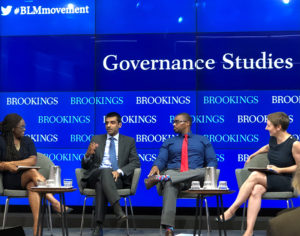BLACK LIVES MATTER: Brookings Holds Discussion on Race, State Violence, and Representation in the United States
 Pictured from left to right: Dr. Nicol Turner-Lee, Chiraag Bains, Dr. Rashawn Ray, and Dr. Vanessa Williamson
Pictured from left to right: Dr. Nicol Turner-Lee, Chiraag Bains, Dr. Rashawn Ray, and Dr. Vanessa Williamson According to data from Mapping Police Violence, police in the United States killed 1,147 people last year. Officers were only charged with a crime in 1 percent of cases. And of the 1,147 people killed, 25 percent were black—despite African Americans being just 13 percent of the population. Black people were more likely to be killed by police, more likely to be unarmed, and less likely to be threatening someone when killed.
This week, on June 19—known as “Juneteenth,” marking the anniversary of the emancipation of African Americans in Texas in 1865 (two years after Lincoln’s Emancipation Proclamation)—the Brookings Institution’s Governance Studies held a panel discussion about the state of the Black Lives Matter movement as it relates to race, state violence, and representation in the US. The discussion was moderated by Vanessa Williamson, a Governance Studies fellow at Brookings. (Watch video recording here.)
The #BlackLivesMatter movement, with fifty-two chapters, was started by three women after George Zimmerman was acquitted in the killing of Trayvon Martin in 2013. As Americans continue to be confronted with the deaths of black Americans, the movement has garnered sustained recognition and support. As panelist Dr. Nicol Turner-Lee, a sociology scholar, reminded the audience in her introduction, “they have names”: Trayvon Martin, Tamir Rice, Tanisha Anderson, Mya Hall, Walter Scott, Sandra Bland. The space that #BlackLivesMatter held and continues to hold helped propel the conversation around the state-sanctioned violence these victims experienced.
The success of the movement is in large part due to its decentralized leadership. Modern day access to cellphones and social media allows civilians to circumvent traditional media. The #BlackLivesMatter hashtag first appeared in posts about the killing of Michael Brown in Ferguson, Missouri, in 2014. But importantly, Dr. Turner-Lee pointed out, there is a difference between a moment and the movement. Absurdly, the circulation of videos are not enough to obtain justice. “We cannot resolve this issue [the issue of the killings of unarmed black Americans] until we go deep into the bowels of how this happened.”
Chiraag Bains, who co-wrote the Ferguson Report and sued the city during his time in the Civil Rights Division of the US Department of Justice (2010-2017), provided context for the current state approach to addressing the problem of officer misconduct. What the general public would consider indisputable evidence isn’t enough to secure convictions of officers. Prosecutors must overcome both jury nullification and jury skepticism. Under the current administration, the US Justice Department has scaled back its caseload of so-called Pattern-or-Practice Investigations. Individual and structural accountability are key to changing the frequency of police misconduct.
Dr. Rashawn Ray, an associate professor of sociology at the University of Maryland, spoke about the research he has done in studying police decision-making and his study of implicit bias. He works with police departments offering expertise to help officers build trust and community with the communities they serve. Through virtual reality simulation, with ninety different scenarios compiled from actual footage of suspicious persons and pullover scenes on the streets of Prince George’s County, researchers studied police officers’ physiological responses to calls. The team then overlaid those results with the demographic information collected from officers. The principal determinant of police response was whether or not the police officer was from the neighborhood where they were policing.
Dr. Ray also explained the endemic culture of silence in police departments; in a paramilitary institution, whistleblowers face demotion and termination. He also urged the need for policies that require outside clinicians to offer mental health services to police officers who may not disclose mental health matters that could potentially compromise their livelihood.
In order to reduce the disproportionate rate black Americans are killed at the hands of police, we need to influence policy decisions at the top. The panelists emphasized the importance of ensuring that a broadly representative community controls the priorities of the police in that community. Police should seek out community input before proposing policies. We need to change overly broad laws that permit a police officer to take a woman to jail for a seatbelt violation (Sandra Bland). Racial profiling is a violation of the Fourteenth Amendment, but local and state legislatures have the power to create legislation that goes beyond the minimum standards of the US Constitution.
Notably, the City of Baltimore paid out $1.1 million in four separate settlements in lawsuits alleging misconduct. That means residents of a city already ranked sixth among America’s poorest cities, are now paying out tax dollars in the aftermath of police conduct. If settlements were instead paid out from officer pensions, Ray proposed, officers would have an incentive to hold each other accountable for maintaining proper conduct. We also should require transparency from our police departments. Internal police sanctions should be made public.
Ultimately, the successful prosecution of police officers is still not a reality, and would provide a visible sign of unwavering support for black lives. As Turner-Lee put it, prosecutions would serve as a “symbolic retransformation of black invisibility.”
Disclaimer: Isabelle Oldfield is a white American female and recognizes that the voices of the community discussed in this article often go silenced. She in no way claims to be an expert on the plight of black Americans and hopes this article will further awareness and discussion of the continued repression of marginalized communities. We have to prove our commitment to our fellow black Americans through our policies, our laws, our actions, and our votes. Change does not happen from complacency.
